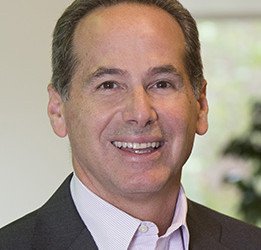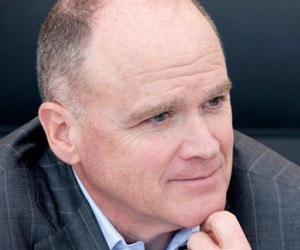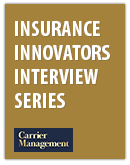This article is part of our insurance innovators interview series.
 Stanley A. Galanski, President and CEO, The Navigators Group, Inc.
Stanley A. Galanski, President and CEO, The Navigators Group, Inc. Mark E. Watson III, President and Chief Executive Officer, Argo Group International Holdings, Ltd.
Mark E. Watson III, President and Chief Executive Officer, Argo Group International Holdings, Ltd. Kevin H. Kelley, Chief Executive Officer, Ironshore Inc.
Kevin H. Kelley, Chief Executive Officer, Ironshore Inc. John Wurzler, President, OneBeacon Technology Insurance
John Wurzler, President, OneBeacon Technology Insurance Alan B. Colberg, President and Chief Executive Officer, Assurant, Inc.
Alan B. Colberg, President and Chief Executive Officer, Assurant, Inc. Manny Rios, President and CEO, American Modern Insurance Group
Manny Rios, President and CEO, American Modern Insurance Group Dave Pratt, General Manager, Usage-Based Insurance, Progressive
Dave Pratt, General Manager, Usage-Based Insurance, Progressive Berto Sciolla, EVP and Manager of North American Treaty Reinsurance,Gen Re
Berto Sciolla, EVP and Manager of North American Treaty Reinsurance,Gen Re Greg Hendrick, Chief Executive, Insurance, XL Catlin
Greg Hendrick, Chief Executive, Insurance, XL Catlin Anand Rao, Principal, PwC U.S. Advisory Practice
Anand Rao, Principal, PwC U.S. Advisory Practice Mike McGavick, Chief Executive Officer, XL Catlin
Mike McGavick, Chief Executive Officer, XL Catlin David M. Lightfoot, Managing Director, Head of GC Analytics – Americas, Guy Carpenter
David M. Lightfoot, Managing Director, Head of GC Analytics – Americas, Guy Carpenter Conan Ward, Chief Executive Officer, Hamilton USA
Conan Ward, Chief Executive Officer, Hamilton USA Ming Lee, Chief Executive Officer, AIR Worldwide
Ming Lee, Chief Executive Officer, AIR Worldwide Laura Hay, National Insurance Sector Leader, KPMG LLP
Laura Hay, National Insurance Sector Leader, KPMG LLP John Lupica, Vice Chairman, ACE Group; Chairman, Insurance–North America
John Lupica, Vice Chairman, ACE Group; Chairman, Insurance–North America
 Conan Ward, Chief Executive Officer, Hamilton USA
Conan Ward, Chief Executive Officer, Hamilton USAQ1: In your view, what has been the greatest innovation in the P/C insurance industry in recent years? Explain.
Ward (Hamilton): One of the biggest innovations in the marketplace has to be the commoditization of large portions of the personal lines market, particularly auto. In order for that change to take place, a number of technological and marketplace changes had to occur: Carriers had to be able to pull electronic data about insureds from public sources; sophisticated predictive models were built to consume that data; and buyers migrated from a traditional agency model to online purchasing.
Q3: In your view, what innovation or innovator outside the insurance industry has had or is having the greatest impact on the P/C insurance industry?
Ward (Hamilton): Google certainly has garnered a lot of attention recently for their driverless cars and their entrance into the industry itself. Given the amount of data their search model generates and the implications of driverless technology on the personal auto market, there have to be some very uncomfortable players in the marketplace.
Moreover, the Internet of Things will have a fundamental impact on our industry. Well-monitored and protected risks will continue to reduce pools of traditional premium by making premises safer.
Q4: Describe one or more ways in which your company encourages innovation. (Feel free to describe any elements of the culture or process.)
Ward (Hamilton): Innovation can come from unexpected places in unexpected ways. By having a creative, open and nonjudgmental environment, we try to encourage brainstorming and creative thinking. Our people are intense and competitive, but we also have to be willing to try new things that might not always work. As a leader, one has to ensure that people feel safe enough to try or suggest somewhat controversial ideas. You have to foster trust in you and trust among teammates.
Q5: What is the biggest obstacle to innovation within the insurance industry? Explain. What is your company doing (or what can the industry do) to overcome this obstacle?
Ward (Hamilton): A few barriers come to mind when one thinks about our industry and innovation.
First, the regulatory system heavily favors existing products and players. In the name of consumer protection, consumer choice is getting short shrift. If each state mandated the size, shape, type and color of cars or clothing sold in its state, what would we be wearing or driving right now?
Second, the legal environment in which the industry operates has created incomprehensible products. We, as an industry, are so focused on what and how to exclude coverage that we forget that a normal person has to read our actual policy. So, we have to ask ourselves whether we’re creating a greater problem than the one we’re solving.
Conan Ward, Hamilton USA
Q8: What is the best book you have read about innovation? The best course or seminar you have attended? What was a key takeaway from the book or education session?
Ward (Hamilton): I’m a big Peter Drucker fan as his common-sense approaches to management, entrepreneurship and innovation resonate with me. A key takeaway for me is that innovation is less about the “eureka” moment and more about hard work—analysis, finding and leading good people, sound strategy, and thoughtful, nimble execution. Innovation starts with a careful analysis of both internal and external data, processes and developments.
Company culture is often a key component in innovative activity. Because existing companies are built around finding, keeping and servicing existing customers, their approach to innovation tends to be incremental rather than revolutionary. New companies are often purpose-built to innovate in a particular industry and are able to attract believers who furnish capital and expertise. Without an existing customer base, those companies have to find a way to get and keep the business or die.
Related Videos
- Will Regulation Hold Back Insurance Innovation, Asks Hamilton USA’s Conan Ward
- Travelers, Hartford,…Hamilton USA? Conan Ward Discusses Hamilton’s Move into the Small Business Insurance Segment
- Hamilton USA Enters the Program Business Arena
- Ex-Reinsurance Exec Leading Insurance Operations at Hamilton
Related Articles
Read more Innovation Insights by Person:
 Stanley A. Galanski, President and CEO, The Navigators Group, Inc.
Stanley A. Galanski, President and CEO, The Navigators Group, Inc. Mark E. Watson III, President and Chief Executive Officer, Argo Group International Holdings, Ltd.
Mark E. Watson III, President and Chief Executive Officer, Argo Group International Holdings, Ltd. Kevin H. Kelley, Chief Executive Officer, Ironshore Inc.
Kevin H. Kelley, Chief Executive Officer, Ironshore Inc. John Wurzler, President, OneBeacon Technology Insurance
John Wurzler, President, OneBeacon Technology Insurance Alan B. Colberg, President and Chief Executive Officer, Assurant, Inc.
Alan B. Colberg, President and Chief Executive Officer, Assurant, Inc. Manny Rios, President and CEO, American Modern Insurance Group
Manny Rios, President and CEO, American Modern Insurance Group Dave Pratt, General Manager, Usage-Based Insurance, Progressive
Dave Pratt, General Manager, Usage-Based Insurance, Progressive Berto Sciolla, EVP and Manager of North American Treaty Reinsurance,Gen Re
Berto Sciolla, EVP and Manager of North American Treaty Reinsurance,Gen Re Greg Hendrick, Chief Executive, Insurance, XL Catlin
Greg Hendrick, Chief Executive, Insurance, XL Catlin Anand Rao, Principal, PwC U.S. Advisory Practice
Anand Rao, Principal, PwC U.S. Advisory Practice Mike McGavick, Chief Executive Officer, XL Catlin
Mike McGavick, Chief Executive Officer, XL Catlin David M. Lightfoot, Managing Director, Head of GC Analytics – Americas, Guy Carpenter
David M. Lightfoot, Managing Director, Head of GC Analytics – Americas, Guy Carpenter Conan Ward, Chief Executive Officer, Hamilton USA
Conan Ward, Chief Executive Officer, Hamilton USA Ming Lee, Chief Executive Officer, AIR Worldwide
Ming Lee, Chief Executive Officer, AIR Worldwide Laura Hay, National Insurance Sector Leader, KPMG LLP
Laura Hay, National Insurance Sector Leader, KPMG LLP John Lupica, Vice Chairman, ACE Group; Chairman, Insurance–North America
John Lupica, Vice Chairman, ACE Group; Chairman, Insurance–North America
Read other innovator’s response by question:
- Q1: The greatest innovation in the P/C insurance industry
- Q2: Describe the greatest innovation at your company
- Q3: Innovation or innovator outside the insurance industry
- Q4: How your company encourages innovation
- Q5: The biggest obstacle to innovation within the insurance industry?
- Q6: The next innovation to impact the P/C insurance industry
- Q7: Your role in leading innovation.
- Q8: Best book you have read about innovation
- Q9: Describe a failed initiative at your company
- Q10: Collaborating with market competitors
- Q11: Can P/C insurers disrupt other industries?
Get all 16 interview neatly packaged in a single PDF download. Explore ideas by personality and by question. More than 60 pages of content.



















 What to Expect in 2026: U.S. P/C Results More Like 2024
What to Expect in 2026: U.S. P/C Results More Like 2024  Why the Middle Market Matters and How Insurers Can Capture It
Why the Middle Market Matters and How Insurers Can Capture It  Market Softening Accelerates During 1/1/2026 Re Renewals
Market Softening Accelerates During 1/1/2026 Re Renewals  Executives on the Move at Liberty Mutual, Cowbell, W. R. Berkley
Executives on the Move at Liberty Mutual, Cowbell, W. R. Berkley 





